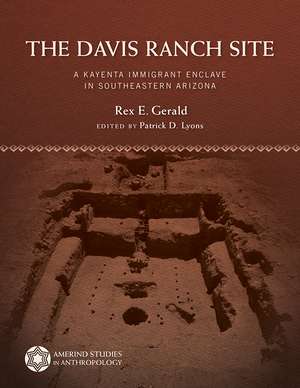The Davis Ranch Site: A Kayenta Immigrant Enclave in Southeastern Arizona: Amerind Studies in Archaeology
Autor Rex E. Gerald Editat de Patrick D. Lyonsen Limba Engleză Hardback – 30 apr 2019
In this new volume, the results of Rex E. Gerald’s 1957 excavations at the Davis Ranch Site in southeastern Arizona’s San Pedro River Valley are reported in their entirety for the first time.
Annotations to Gerald’s original manuscript in the archives of the Amerind Museum and newly written material place Gerald’s work in the context of what is currently known regarding the late thirteenth-century Kayenta diaspora and the relationship between Kayenta immigrants and the Salado phenomenon. Data presented by Gerald and other contributors identify the site as having been inhabited by people from the Kayenta region of northeastern Arizona and southeastern Utah.
The results of Gerald’s excavations and Archaeology Southwest’s San Pedro Preservation Project (1990–2001) indicate that the people of the Davis Ranch Site were part of a network of dispersed immigrant enclaves responsible for the origin and spread of Roosevelt Red Ware pottery, the key material marker of the Salado phenomenon.
A companion volume to Charles Di Peso’s 1958 publication on the nearby Reeve Ruin, archaeologists working in the U.S. Southwest and other researchers interested in ancient population movements and their consequences will consider this work an essential case study.
Annotations to Gerald’s original manuscript in the archives of the Amerind Museum and newly written material place Gerald’s work in the context of what is currently known regarding the late thirteenth-century Kayenta diaspora and the relationship between Kayenta immigrants and the Salado phenomenon. Data presented by Gerald and other contributors identify the site as having been inhabited by people from the Kayenta region of northeastern Arizona and southeastern Utah.
The results of Gerald’s excavations and Archaeology Southwest’s San Pedro Preservation Project (1990–2001) indicate that the people of the Davis Ranch Site were part of a network of dispersed immigrant enclaves responsible for the origin and spread of Roosevelt Red Ware pottery, the key material marker of the Salado phenomenon.
A companion volume to Charles Di Peso’s 1958 publication on the nearby Reeve Ruin, archaeologists working in the U.S. Southwest and other researchers interested in ancient population movements and their consequences will consider this work an essential case study.
Preț: 626.48 lei
Preț vechi: 764.00 lei
-18% Nou
Puncte Express: 940
Preț estimativ în valută:
119.89€ • 130.18$ • 100.71£
119.89€ • 130.18$ • 100.71£
Carte indisponibilă temporar
Doresc să fiu notificat când acest titlu va fi disponibil:
Se trimite...
Preluare comenzi: 021 569.72.76
Specificații
ISBN-13: 9780816538546
ISBN-10: 0816538549
Pagini: 824
Ilustrații: 272 color illustrations, 158 tables
Dimensiuni: 216 x 279 x 46 mm
Greutate: 2.81 kg
Editura: University of Arizona Press
Colecția University of Arizona Press
Seria Amerind Studies in Archaeology
ISBN-10: 0816538549
Pagini: 824
Ilustrații: 272 color illustrations, 158 tables
Dimensiuni: 216 x 279 x 46 mm
Greutate: 2.81 kg
Editura: University of Arizona Press
Colecția University of Arizona Press
Seria Amerind Studies in Archaeology
Notă biografică
Rex E. Gerald, who excavated the Davis Ranch Site as a predoctoral research fellow at the Amerind Foundation, was later director of the Centennial Museum and an associate professor of anthropology at the University of Texas at El Paso.
Patrick D. Lyons is the director of the Arizona State Museum and an associate professor of anthropology at the University of Arizona. He is co-editor of Migrants and Mounds: Classic Period Archaeology of the Lower San Pedro Valley.
Patrick D. Lyons is the director of the Arizona State Museum and an associate professor of anthropology at the University of Arizona. He is co-editor of Migrants and Mounds: Classic Period Archaeology of the Lower San Pedro Valley.
Cuprins
Preface and Acknowledgments by Patrick D. Lyons
1. Context by Patrick D. Lyons
2. Background and Procedures
3. Architecture and Miscellaneous Features
4. Burial Practices
5. Artifacts
6. Pottery Types
7. Roosevelt Red Ware, Maverick Mountain Series Pottery, and Perforated Plates from the Davis Ranch Site by Patrick D. Lyons
8. The Significance of the Davis Ranch Site by Jeffery J. Clark and Patrick D. Lyons
Appendices
References Cited
Contributors
Index
1. Context by Patrick D. Lyons
2. Background and Procedures
3. Architecture and Miscellaneous Features
4. Burial Practices
5. Artifacts
6. Pottery Types
7. Roosevelt Red Ware, Maverick Mountain Series Pottery, and Perforated Plates from the Davis Ranch Site by Patrick D. Lyons
8. The Significance of the Davis Ranch Site by Jeffery J. Clark and Patrick D. Lyons
Appendices
References Cited
Contributors
Index
Recenzii
“Patrick D. Lyons masterfully presents Rex E. Gerald’s work at the Davis Ranch site while adding new analysis and interpretation. This book presents important evidence about both the migration of Kayenta people to southern Arizona and the nature of the 1300s Kayenta diaspora.” —James R. Allison, Department of Anthropology, Brigham Young University
“Patrick D. Lyons provides a comprehensive view of one of the most important sites of prehistoric migrations in the Americas—Davis Ranch—painstakingly weaving Rex E. Gerald’s sixty-year-old notes and analyses together with modern understandings. Lyons also provides a stunning new study of Salado ceramics.” —Catherine M. Cameron, Department of Archaeology, University of Colorado, Boulder
“Patrick D. Lyons provides a comprehensive view of one of the most important sites of prehistoric migrations in the Americas—Davis Ranch—painstakingly weaving Rex E. Gerald’s sixty-year-old notes and analyses together with modern understandings. Lyons also provides a stunning new study of Salado ceramics.” —Catherine M. Cameron, Department of Archaeology, University of Colorado, Boulder
Descriere
In this volume, the results of Rex Gerald’s 1957 excavations at the Davis Ranch site in southeastern Arizona's San Pedro River Valley are reported in their entirety for the first time. Annotations to Gerald’s original manuscript and newly written material place Gerald’s work in the context of what is currently known regarding the late thirteenth-century Kayenta diaspora and the relationship between Kayenta immigrants and the Salado phenomenon.















